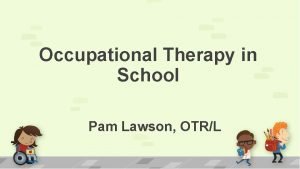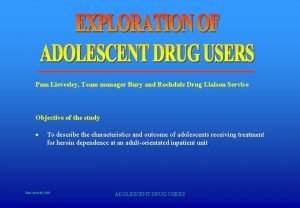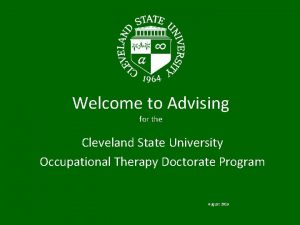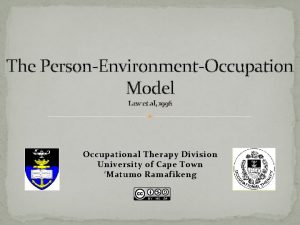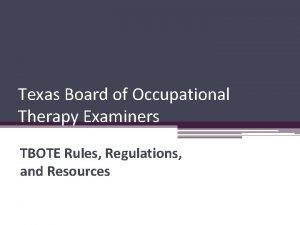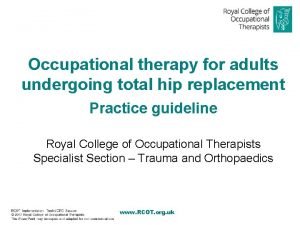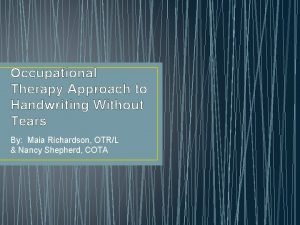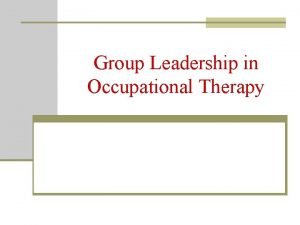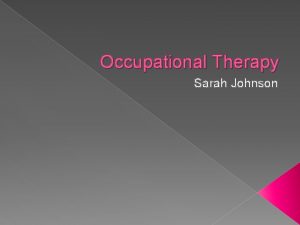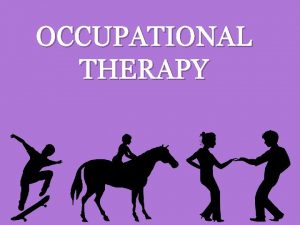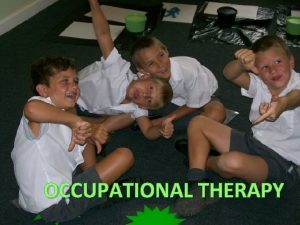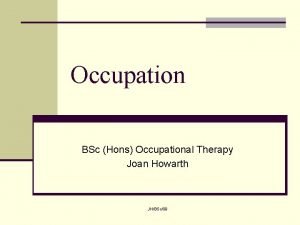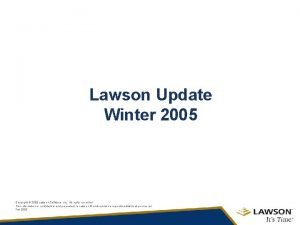Occupational Therapy in School Pam Lawson OTRL Occupation












- Slides: 12

Occupational Therapy in School Pam Lawson, OTR/L

Occupation: a job or way of spending time Performance Areas A child’s job is to be a student • • Sensory integration: for posture, self-regulation, attention, motor sequencing and planning Fine Motor Skills: for the manipulation of classroom tools and self-help skills. Visual perception: in order to interpret, analyze and give meaning to what is seen. Visual motor integration: for coloring, drawing, handwriting

Sensory Processing The procedure in which we take in and interpret messages from our bodies and surroundings, and organize purposeful responses • Muscle Tone / Postural Stability • Self-Regulation / Attention • Motor Planning, Coordination, Bilateral Integration • Sensory Seeking / Avoidant Behaviors

Fine Motor Relates Skills to strength, coordination and dexterity for the manipulation of classroom tools (pencils, scissors, glue, tape, hole punch, ruler etc. ) Required for self-help skills (managing clothing and fasteners, tying laces, opening snack/lunch containers, utensil usage). • • • Grasp Patterns Finger Opposition Intrinsic muscle strength In-hand manipulation Speed and dexterity

Visual Perception The ability to interpret, analyze and give meaning to what is seen. Visual perception is an important cognitive skill required for all academic tasks. Visual perception is required for… • • • Learning letters Sight words Spelling Spatial concepts Problem solving Conceptual skills

Visual Perception • • Visual Discrimination Visual Memory Sequential Memory Spatial Relationships Visual Figure Ground Form Constancy Visual Closure

Visual Motor Integration The ability to integrate visual stimuli with motor control Eye-hand coordination • • • Coloring Cutting Pasting Drawing Handwriting

Referrals for Occupational Therapy come from the Instructional Support Team (IST). • An area of deficit is identified • An OT observation may be performed • It is determined if a student requires further assessment through a formal evaluation • Classroom support may be provided with suggestions for modification, or activities to facilitate development

What does a typical OT session look like? • Engaging, motivating activities • Multiple performance areas targeted within each session • Usually treatment is provided within a small group

Visual Perceptual • Focus on discrimination skills • Concepts of size, proportion, position & directionality • Puzzles/Geoboards Occupational • Tangram designs Therapy • Eye-Spy/Spot-It Activities • Picture Finds • Letter/Word Searches Visual Motor • Emphasis on integrating visual stimuli with motor control (eye-hand coordination) • Mazes, Crossword Puzzles • Drawing/Copying/ Handwriting Sensory Motor • Use of specific movement activities to target the head, body and eye movements • Use of trampoline, scooter board, ramp, or directed movement games including jumping, rolling, or eye/head movement games Fine Motor • Use of tools to facilitate grasp including pencils, markers, glue, scissors, hole punch, push pins • Dice, beads, coins • Tongs, clay • Clothes Pins

HANDWRITING SKILLS Focuses On… • Letter Formation • Line Targeting & Orientation • Spacing & Organization on Page Purpose: To develop fluency & automaticity Writing will become a tool for the completion of higher-level academics

QUESTIONS ? THANK YOU! Pam Lawson, OTR/L Email: plawson@csh. k 12. ny. us
 Bioness integrated therapy system price
Bioness integrated therapy system price Pam lawson
Pam lawson Bury pam pam
Bury pam pam Occupational therapy cleveland state
Occupational therapy cleveland state Peo framework occupational therapy
Peo framework occupational therapy Occupational areas
Occupational areas Alert program occupational therapy
Alert program occupational therapy Texas occupational therapy license renewal
Texas occupational therapy license renewal Backward chaining occupational therapy
Backward chaining occupational therapy Occupational therapy and environmental sustainability
Occupational therapy and environmental sustainability Occupational therapy intervention plan for hip arthroplasty
Occupational therapy intervention plan for hip arthroplasty Handwriting without tears teaching order
Handwriting without tears teaching order Kurt lewin leadership styles
Kurt lewin leadership styles

